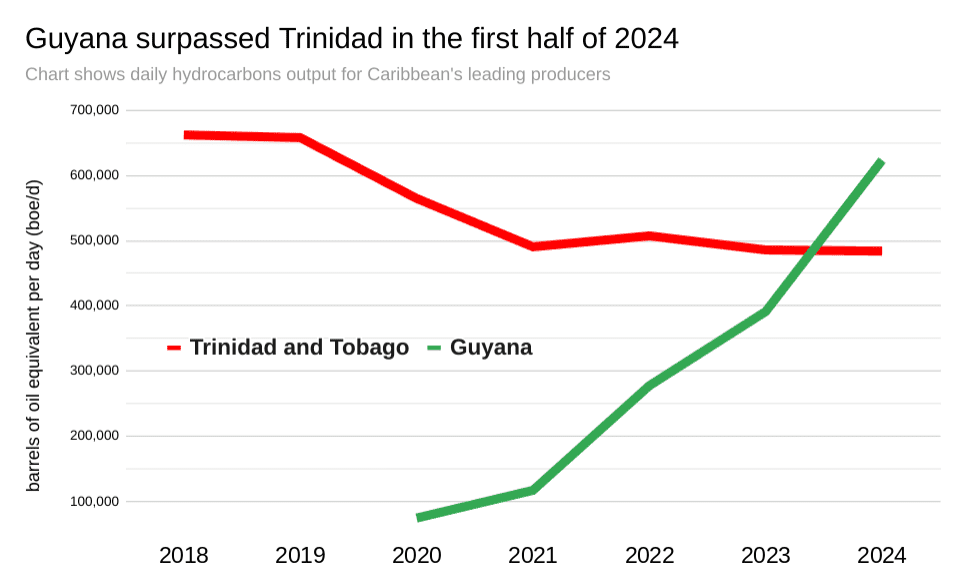Guyana now produces more hydrocarbons in the Caribbean region than veteran producer Trinidad and Tobago (TT).
Data from TT’s Ministry of Energy and Energy Industries shows oil and condensate production of 50,246 barrels per day (b/d) in the first four months of 2024. Gas production in the same period averaged almost 2.6 billion standard cubic feet per day (mscf/d). Collectively, this amounts to approximately 484,000 barrels of oil equivalent per day (boe/d).
Trinidad’s hydrocarbon production is on a steady decline, down from approx. 719,000 boe/d in 2015. Trinidad is hoping cross-border cooperation with Venezuela brings some gas projects to fruition to help buoy its declining output, including the highly anticipated Dragon project.
Guyana, on the other hand, started oil production in December 2019 and is experiencing significant annual increases. ExxonMobil, the sole operator with projects in production, has added an average of 98,000 b/d in the period 2020-2024. In the first four months of 2024, oil production averaged 616,000 b/d. Considering data for May-June, the half-year average jumps to 623,000 b/d, based on data from the Ministry of Natural Resources.

While the standardized conversion of hydrocarbons into barrels of oil equivalent per day makes comparison simple, oil and gas differ significantly in their market value, applications, and the products derived from them. Oil is primarily refined into fuels such as gasoline, diesel, and jet fuel, with a significant portion also used in the production of petrochemicals. Natural gas, which makes up the bulk of Trinidad’s production, is in contrast predominantly used for electricity generation, heating, and as a feedstock for chemical production, including fertilizers.
Yet, the comparison highlights a significant turning point in the Caribbean’s energy landscape. Trinidad and Tobago, a veteran producer with over a century of industry experience, is now seeing its production decline as its reserves mature. Meanwhile, Guyana, having commenced production only five years ago, is experiencing an oil boom.
In addition to current oil developments, three more Guyana projects will begin production in the lead-up to 2027. These projects, all led by ExxonMobil, are expected to take oil production capacity to more than 1.3 million b/d. Exxon is also seeking approval for a seventh project that could boost levels to 1.5 million b/d. Even before that, Guyana is set to become the largest per capita oil producer in 2025.
Though Guyana only produces oil for export, Exxon is set to bring natural gas from the Liza field to shore in 2025 at an initial rate of 50 million scf/d. Exxon and a U.S. startup Fulcrum LNG are expected to consider pursuing a standalone gas development, which would produce gas on a larger scale, for export.



